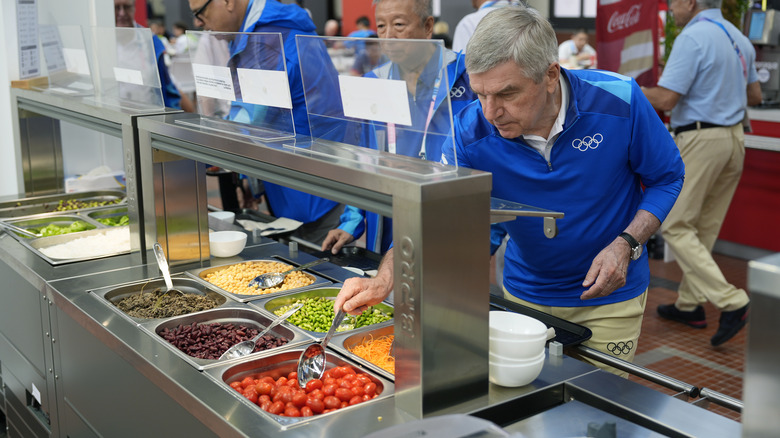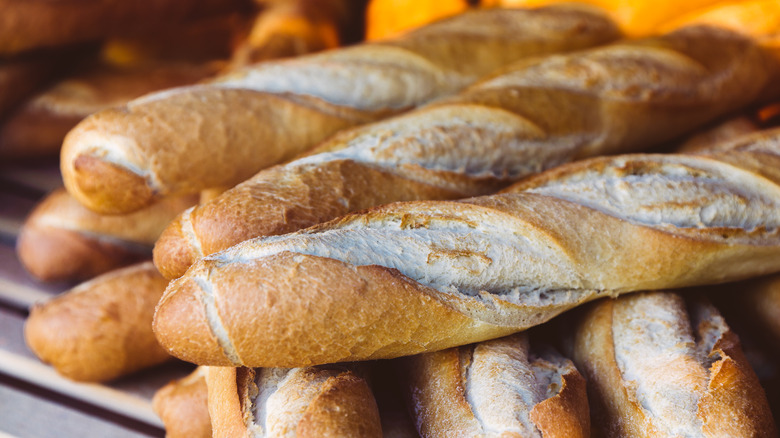What Athletes Are Eating At The 2024 Paris Olympics
For the 2024 Summer Olympics in Paris, 10,500 athletes are coming together to compete. There will be swimming, archery, gymnastics, running, cycling, volleyball, and more — and all those competitors certainly have to eat to prepare and refuel. Including the support staff at the Olympic Village, around 40,000 meals are dished out every single day. For the duration of the summer games, athletes will be able to choose from around 500 different recipes that fall under four different cuisine umbrellas: French (with two daily options), Asian, African-Caribbean, and World (again with two options). Within these genres, various dietary restrictions, nutritional needs, and cultural necessities are all addressed.
There really is something for everyone. One of the recipes in the French category is a veggie bourguignon or a brandade de morue — vegetables stewed in a rich red wine sauce or iconic mashed potatoes with salt cod. A ground pork and Thai basil dish served with basmati rice and turmeric roasted vegetables falls under the Asian theme — while fried shrimp and sauteed peppers, onions, and tomatoes with North African garlic and herb chermoula sauce is served up for the African-Caribbean category. The World cuisine features daily options like lamb in mint sauce or a vegetable moussaka.
Aside from main courses, the dining hall also has various stations set up for items like fruit, salads, pastries, and desserts. Athletes can personalize their meals with a salad bar, grill station, condiment bar, and so much more — featuring 85 different options throughout.
The plan behind the food at the Paris Olympics
The company responsible for catering the Olympic Games is Sodexo Live, a subset of Sodexo. The parent corporation provides food services and facilities management in sectors such as higher education, government, healthcare, and business, and Sodexo Live focuses specifically on supplying locales like stadiums, arenas, and convention centers.
A team of chefs is also key to running the show. Sodexo executive chefs Charles Guilloy and Stephane Chicheri are at the helm, with additional support from Akrame Benallal, Amandine Chaignot, and Alexandre Mazzia — French chefs with well-known restaurants. They designed the menu — which was originally meant to cover nine different culinary themes and around 1,000 recipes — along with help from sports nutritionists and the Paris 2024 Athletes Commission. They even got dietary advice from major players like the United States, Australia, Canada, and China.
With a commitment to sustainability and climate change awareness, the main dining hall is skipping the disposable plates for the very first time. Around one-third of the food offered is plant-based, 30% is organic, and all but 20% will be sourced from within France itself. In fact, food items like avocados are not on the menus at all because of how far they would need to travel to get all the way to Paris — most avocados are produced in Mexico. Only three items are being imported from great distances: bananas, chocolate, and coffee.
Gastrodiplomacy at the Olympics
The main goal of the catering at the Olympic Village is to make sure athletes have the fuel they need to get the job done. However, the offerings are also a way for the host country to showcase its own unique culinary traditions through gastrodiplomacy. This is when a country uses food to present a favorable public image, build connections, and share culture.
The 1984 Olympics in Los Angeles, California set the stage for gastrodiplomacy at this event. A bounty of fresh California produce, unlimited servings, and food that was both classically American and reflective of the myriad of immigrant communities defined this Olympic Village. At the 1988 Olympics in Seoul, Korea, serving kimchi is part of what helped the dish proliferate across the globe, and the Tokyo Olympic Village had an entire dining hall dedicated just to Japanese food where athletes could sample dumplings, spring rolls, ramen, fish-free sushi, curry rice, and more.
In Paris, French cuisine receives a special spotlight. There is a station devoted specifically to cheese, and of course, there are plenty of croissants. To evoke the feeling and aroma of walking through a French town, there is also an in-house bakery that cranks out up to 800 baguettes a day. Beyond just what there is to eat, the organizing chefs will have special events where they present different French dishes, and athletes can even partake in bread and pastry making workshops.



